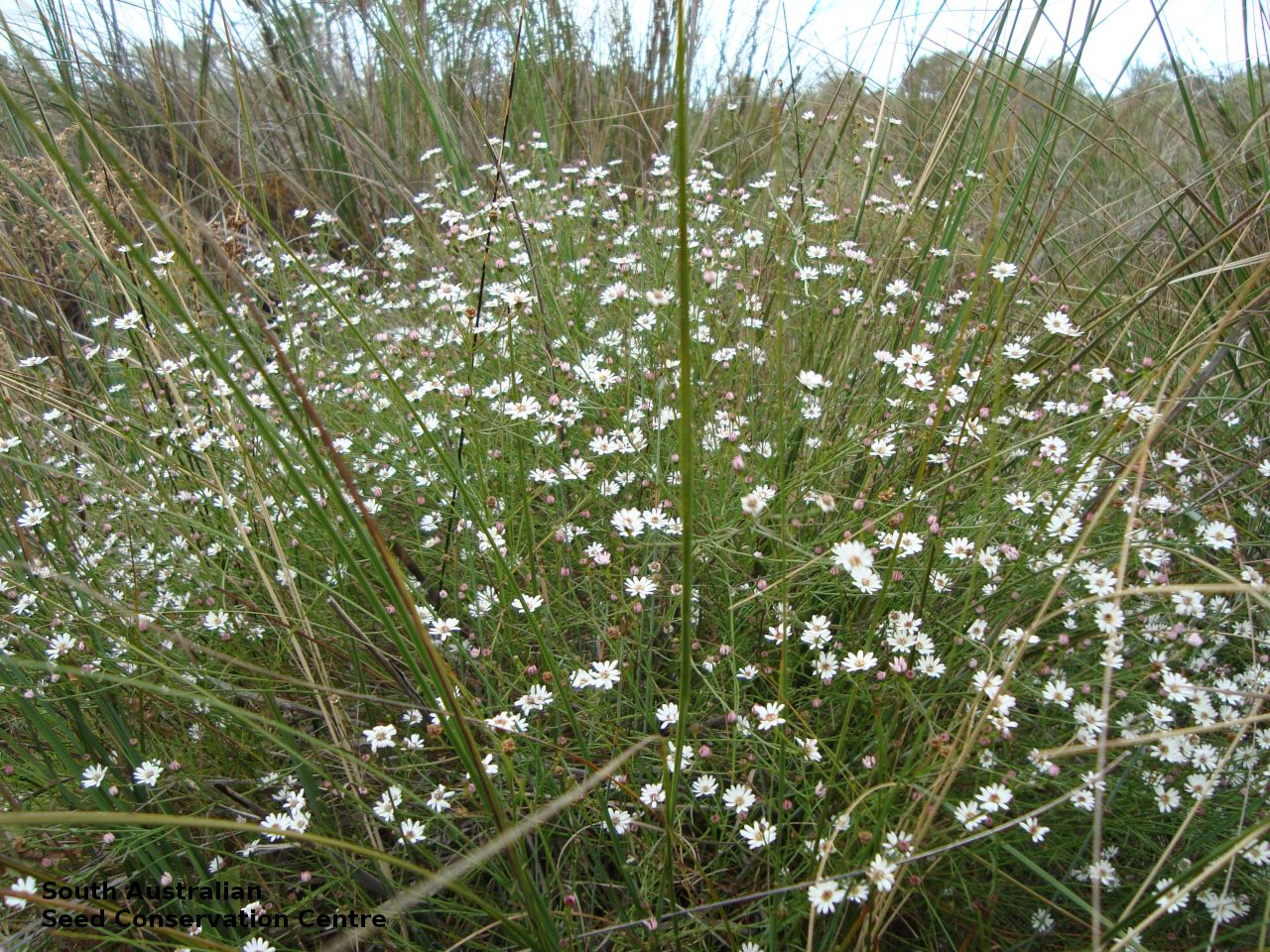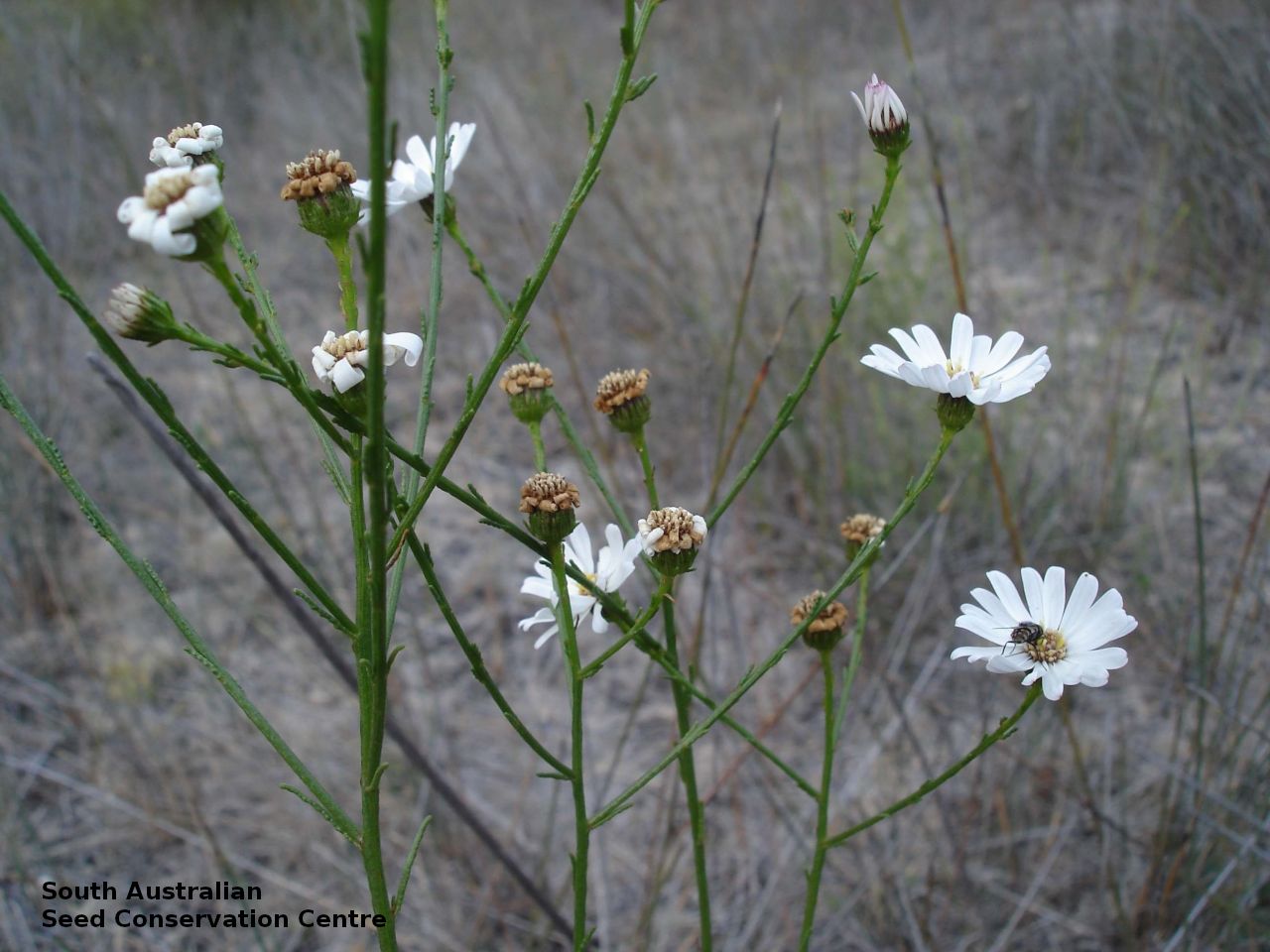






















Botanical art
Etymology
Olearia named after Johann Gottfried �lschl�ger (1603-1671), a German horticulturist and author of Flora of Halle in Germany (his name was Latinized to Olearius). Alternatively, it maybe from the Latin 'olearius' pertaining to oil, from 'olea', for olive tree; alluding to the first named species resembling the olive. Suffruitcosa from the Latin 'suffruticosus' meaning subshrubby or somewhat woody, referring to the habit of the species.
Distribution and status
Found in two locations in the South-east in South Australia, growing on swampy ground of low nutrient. Also found in Victoria. Native. Very rare in South Australia. Very rare in Victoria.
Herbarium region: South Eastern
NRM region: South East
AVH map: SA distribution map (external link)
Plant description
Erect, short-lived subshrub to 70 cm high with sticky slender shoots arising from a woody stock. Stems erect, striate, glabrous, green, with divaricate branches above forming a lax corymbose panicle. Leaves sessile, more or less erect to subappressed, linear, entire, obtuse or the uppermost ones apiculate, to 24 mm long and 0.8 mm wide, decreasing in size up the stem, subterete, channeled above, convex on the lower side, glabrous. Inflorescence panicle like with white to pink daisy flowers. Flowering between February and May. Fruits are fluffy white heads. Seeds are pale brown obovoid seed to 2 mm long and 0.8 mm wide, covered in dense hairs and short barbed pappus. Seed embryo type is spatulate fully developed.
Seed collection and propagation
Collect seeds between April and June. Collect heads that are large and fluffy. Either pick off the whole heads or use your finger and pull off the seeds from the head. Mature seeds will come off easily. Place the heads in a tray for a week to dry. No cleaning is required if only pure seeds are collected. If heads are collected, then rub the heads gently with your hands to dislodge the seeds. Viable seeds will be fat and hard. Store the seeds with a desiccant such as dried silica beads or dry rice, in an air tight container in a cool and dry place. From nine collections, the seed viability were average to high, ranging from 60% to 100%. Seeds are non-dormant, viable seed should germinate readily.
| Location | No. of seeds (weight grams) | Number of plants | Date collected | Collection number Collection location | Date stored | % Viability | Storage temperature |
|---|---|---|---|---|---|---|---|
| MSB | 3,600 (1 g) | 40-50 | 9-May-2006 | DJD464 South Eastern | 85% | ||
| BGA MSB | 7,270 (2 g) 3,600 (1 g) | 50 | 12-Apr-2006 | DJD464 South Eastern | 14-Sep-2006 | 85% | +5°C, -18°C |
| BGA | 5,800 (4.02 g) | 50 | 3-Apr-2007 | DJD779 South Eastern | 1-Aug-2007 | 70% | +5°C, -18°C |
| BGA | 7,900 (1.1 g) | 10 | 23-Apr-2009 | DJD1496 South Eastern | 20-Jul-2009 | 100% | -18°C |
| BGA | 3,300 (0.6 g) | 25+ | 23-Apr-2009 | DJD1400 South Eastern | 20-Jul-2009 | 100% | -18°C |
| BGA | 3,200 (0.68 g) | 30+ | 28-May-2009 | TST737 South Eastern | 20-Jul-2009 | 100% | -18°C |
| BGA | 1,200 (0.4 g) | 10 | 29-Apr-2010 | DJD1400 South Eastern | 1-Jun-2010 | 60% | -18°C |
| BGA | 6,000 (2.02 g) | 20+ | 29-Apr-2010 | TST737 South Eastern | 1-Jan-2012 | 70% | -18°C |
Number of plants: This is the number of plants from which the seeds were collected.
Collection location: The Herbarium of South Australia's region name.
% Viability: Percentage of filled healthy seeds determined by a cut test or x-ray.